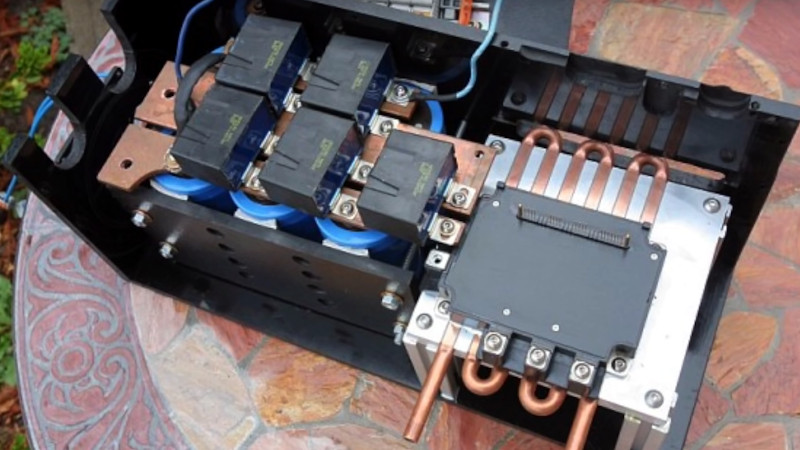Many of us will have experimented with brushless motors, and some of us will have built our own controllers rather than using an off-the-shelf part. Doing so is a good way to understand their operation, and thus to design better brushless motor powered projects. Few of us will have gone as far as [etischer] though, and embarked upon building our own controller for a 300V 90kW traction motor.
The tricky part of a high power brushless motor controller lies not in the drive but in the high-power switching arrangements. He’s using a bank of IGBTs, and to drive them he’s using a smaller industrial variable frequency drive controller with its own output transistors removed. He takes us through some of the development of the system, including showing him blowing up a set of IGBTs through having too much inductance between transistors and reservoir capacitor, and then to his final design.
This is part of a project VW first converted ten years ago, and as part of a series of videos he’s produced one going through the whole project. It’s a fascinating breakdown of the parts required for an EV conversion, and the teething troubles he’s encountered along the way.
Thanks [jafinch78] for the tip.
















Imagine blowing up one of those IGBT’s during testing. Must be a heartbreaking experience figuring they cost a couple of $100. Still a really fun and knowledgeable project if you can spare the cash.
“I installed 25 Red Top Optima batteries for testing purposes…”
Yeah, I think this gentleman’s budget definitely could absorb a blown IGBT or two.
Normally, when designing a traction inverter, you add a desaturation-detection to the IGBT drivecircuit (or it is included in the gatedriver). Since IGBT desat behaviour is well studied, blowing up one of those should be pretty rare. Also set a proper deadtime :D
My guess would be the existing gate drivers in the variable frequency drive are undersized for the gate capacitance of the larger IGBTs, and coupled with wire length between the two… resulted in too much time in the linear region which over heated and popped the IGBT.
Yeah but I believe the IGBTs suffered from voltage ripples exeding the maximum Vce since it is mentioned in the text. Something that possibly could have been stopped with a snubber network. Still lots of things that could go wrong when dealing with high currents and switching transistors.
“…including showing him blowing up a set of IGBTs through having too much inductance between transistors and reservoir capacitor, and then to his final design.”
I thought that was a DRSSTC H-bridge when the picture first loaded. I guess high current, low inductance buses all look pretty similar :)
I thought that was a DRSSTC H-bridge when the picture first loaded. I guess high current, low inductance buses all look the same :)
Back in the day, my son lived next to a grungy mech/sparky, that was contracted by GM to build an electric powered GM car. Much later, GM released the first EV as a lease project, then recalled and crushed. Today, EVs are everywhere,
How time flies.
I thought one of those had survived somehow. Cannot remember or find where I read it though.
The story is here..
https://en.wikipedia.org/wiki/General_Motors_EV1
Are there any non-youtube links associated with this project? I’m curious, but not curious enough to slog through youtube video.
Just found this page looking up the referring URLs to my Passat EV YouTube video. I have a webpage about the build here http://etischer.com/awdev/
Cheers!
See those white stickers on his bumpers? That means he got DMV to accept his build. Great work!
I’m guessing that it varies from state to state, but generally speaking what does it take to get that done (i.e., DMV approval)? One of my long (really way long) term plans is to convert a motorbike into an EV and I’m wondering what does it take to get it approved for street use (i.e., registered and insured).
BTW, I’ve not watched the videos above, they also showed up on my YT recommended list some time back. I just knew the guy’s done an awesome job and that whatever he’s done is way beyond my capability.
In the US street use should be easy. Maybe in some states like PA where there are annual inspections it would be different.
But this is another level by getting HOV Lane (car pool lane) stickers. I understood the standard for that was only commercially manufactured vehicles or kits that were vehicle specific. Very good job sir.
In Illinois…
I had to take pictures of the:
Exterior of the vehicle.
Engine compartment.
Battery pack.
Drive train.
And MAIL them into the Springfield DMV.
A few weeks later I got my EV plate in the mail.
Here in NC, you just have to have the vehicle inspected by a DMV inspector to verify that it’s electric and the “Fuel” field on the title is changed to Electric and the vehicle is exempt from emissions testing.
Great work!